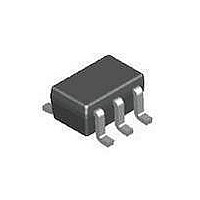SIP32411DR-T1-GE3 Vishay, SIP32411DR-T1-GE3 Datasheet - Page 9

SIP32411DR-T1-GE3
Manufacturer Part Number
SIP32411DR-T1-GE3
Description
Power Switch ICs - Power Distribution 2A 1.2V Slew Rate Ctrl Load Switch
Manufacturer
Vishay
Series
-r
Type
High Sider
Datasheet
1.SIP32411DR-T1-GE3.pdf
(13 pages)
Specifications of SIP32411DR-T1-GE3
On Resistance (max)
76 mOhms
Maximum Operating Temperature
+ 85 C
Minimum Operating Temperature
- 40 C
Package / Case
SC70-6
Maximum Power Dissipation
324 mW
Mounting Style
SMD/SMT
Number Of Switches
Single
Off Time (max)
1 us
On Time (max)
210 us
Supply Current
2 A
Supply Voltage (max)
5.5 V
Supply Voltage (min)
1.1 V
Switch Configuration
Single
Switch Current (typ)
2.4 A
Input Type
Non-Inverting
Number Of Outputs
1
On-state Resistance
101 mOhm
Current - Output / Channel
2A
Current - Peak Output
2.2A
Voltage - Supply
1.1 V ~ 5.5 V
Operating Temperature
-40°C ~ 85°C
Mounting Type
Surface Mount
Lead Free Status / Rohs Status
Details
Available stocks
Company
Part Number
Manufacturer
Quantity
Price
Company:
Part Number:
SIP32411DR-T1-GE3
Manufacturer:
TI
Quantity:
101
Part Number:
SIP32411DR-T1-GE3
Manufacturer:
VISHAY/威世
Quantity:
20 000
DETAILED DESCRIPTION
SiP32411 is an n-channel power MOSFET designed as high
side load switch with slew rate control to prevent in-rush
current. Once enable the device charge pumps the gate of
the power MOSFET to 5 V gate to source voltage while
controlling the slew rate of the turn on time. The mostly
constant gate to source voltage keeps the on resistance low
through out the input voltage range. When disable, the
output discharge circuit turns on to help pull the output
voltage to ground more quickly. Also in disable mode, the
reverse blocking circuit is activated to prevent current from
going back to the input in case the output voltage is higher
than the input voltage. Input voltage is needed for the reverse
blocking circuit to work properly, it can be as low as V
APPLICATION INFORMATION
Input Capacitor
While a bypass capacitor on the input is not required,
a 2.2 µF or larger capacitor for C
all applications. The bypass capacitor should be placed as
physically close as possible to the SiP32411 to be effective
in minimizing transients on the input. Ceramic capacitors are
recommended over tantalum because of their ability to
withstand input current surges from low impedance sources
such as batteries in portable devices.
Output Capacitor
A 0.1 µF capacitor or larger across V
recommended to insure proper slew operation. C
increased without limit to accommodate any load transient
condition with only minimal affect on the SiP32411 turn on
slew rate time. There are no ESR or capacitor type
requirement.
Enable
The EN pin is compatible with both TTL and CMOS logic
voltage levels.
Protection Against Reverse Voltage Condition
The SiP32411 contains a reverse blocking circuitry to protect
the current from going to the input from the output in case
where the output voltage is higher than the input voltage
when the main switch is off. A supply voltage as low as the
minimum required input voltage is necessary for this circuitry
to work properly.
Thermal Considerations
The SiP32411 is designed to maintain a constant output load
current. Due to physical limitations of the layout and
assembly of the device the maximum switch current is 1.8 A
for SC70-6 package and 2.4 A for TDFN4 package, as stated
in the Absolute Maximum Ratings table. However, another
limiting characteristic for the safe operating load current is
the thermal power dissipation of the package. To obtain the
highest power dissipation (and a thermal resistance of
Vishay Siliconix maintains worldwide manufacturing capability. Products may be manufactured at one of several qualified locations. Reliability data for Silicon
Technology and Package Reliability represent a composite of all qualified locations. For related documents such as package/tape drawings, part marking, and
reliability data, see www.vishay.com/ppg?66710.
Document Number: 66710
S11-0367-Rev. D, 07-Mar-11
IN
is recommended in almost
OUT
and GND is
OUT
may be
IN(min)
.
240 °C/W for SC70-6 and 170 °C/W for TDFN4) the power
pad of the device should be connected to a heat sink on the
printed circuit board.
The maximum power dissipation in any application is
dependant
T
for the TDFN4 1.2 mm x 1.6 mm package, θ
and the ambient temperature, T
expressed as:
P
It then follows that, assuming an ambient temperature of
70 °C, the maximum power dissipation will be limited to about
324 mW.
So long as the load current is below the 2.0 A limit, the
maximum continuous switch current becomes a function two
things: the package power dissipation and the R
ambient temperature.
As an example let us calculate the worst case maximum load
current at T
occurs at an input voltage of 1.2 V and is equal to 75 mΩ. The
R
the following formula:
R
Where T
we have
R
= 86.5 mΩ
The maximum current limit is then determined by
I
which in case is 1.94 A. Under the stated input voltage
condition, if the 1.94 A current limit is exceeded the internal
die temperature will rise and eventually, possibly damage the
device.
LOAD
J(MAX)
DS(ON
DS(ON)
DS(ON)
(max.)
(max.)
) at 70 °C can be extrapolated from this data using
= 125 °C, the junction-to-ambient thermal resistance
(at 70 °C) = R
(at 70 °C) = 75 mΩ x (1 + 0.0034 x (70 °C - 25 °C))
C
=
is 3400 ppm/°C. Continuing with the calculation
<
T
A
on
J
= 70 °C. The worst case R
(max.)
R
θ
P
J
the
DS
(max.)
-
A
(
ON
-
DS(ON)
T
maximum
)
A
=
(at 25 °C) x (1 + T
A
125
, which may be formulaically
Vishay Siliconix
170
-
junction
T
A
SiP32411
DS(ON)
J-A
www.vishay.com
temperature,
DS(ON)
= 170 °C/W,
C
x ΔT)
at 25 °C
at the
9












